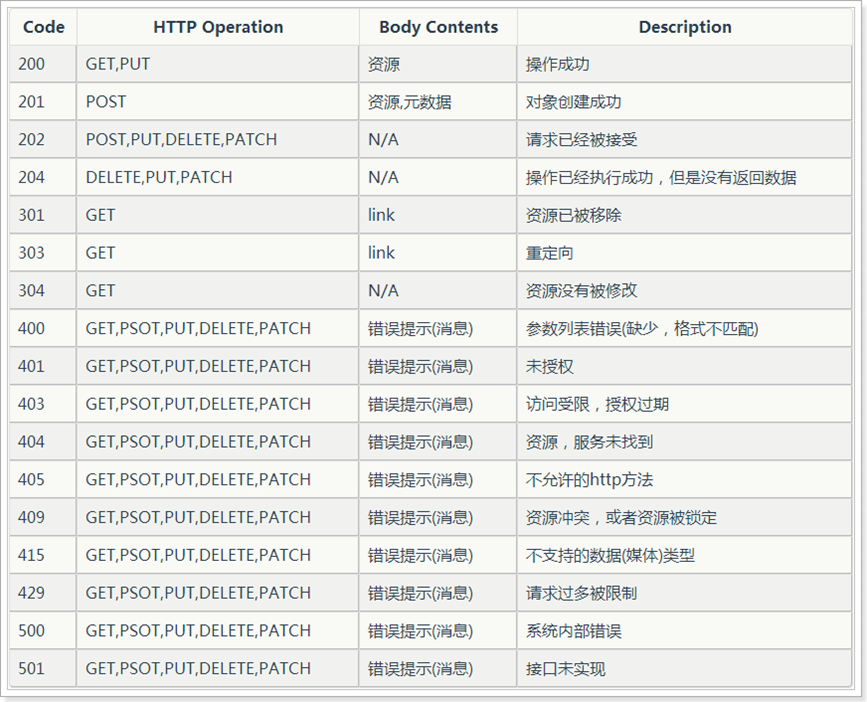1.首先我们说一下Http协议是无状态的
HTTP协议是无状态的,我们看到查到的用到的返回404,500,200,201,202,301.这些不是HTTP协议的状态码。
是HTTP的状态码,就是HTTP请求服务器返回的状态码。HTTP协议和HTTP请求返回状态码是二回事。
HTTP请求方法并不是只有GET和POST,只是最常用的。据RFC2616标准(现行的HTTP/1.1)得知,通常有以下8种方法:OPTIONS、GET、HEAD、POST、PUT、DELETE、TRACE和CONNECT。
HTTP请求方法并不是只有GET和POST,只是最常用的。据RFC2616标准(现行的HTTP/1.1)得知,通常有以下8种方法:OPTIONS、GET、HEAD、POST、PUT、DELETE、TRACE和CONNECT。
HTTP请求方法并不是只有GET和POST,只是最常用的。据RFC2616标准(现行的HTTP/1.1)得知,通常有以下8种方法:OPTIONS、GET、HEAD、POST、PUT、DELETE、TRACE和CONNECT。
重要的事情说三遍
2.现在比较流行的RSETful Web服务架构
关于REST及RESTful的概念,已有不少文章介绍,这里整理几篇我觉得不错的参考:
- 维基百科的定义: REST
- 什么是REST跟RESTful? REST理论的中文详述,其中你可以了解到WCF Restful属于RPC 样式的 Web 服务,ASP.NET Web API属于RESTful Web 服务。
- 深入浅出REST InfoQ的专文介绍,文中甚至有Roy T. Fielding当年REST博士论文的中文翻译链接。另外值得一提的,大家可能没听过Roy Fielding的大名,但如果得知他是HTTP规格的主要作者及Apache HTTP Server项目的发起人之一,应该不会有人怀疑他在Web技术领域的分量
REST是什么?
REST ( REpresentational State Transfer ),State Transfer 为 "状态传输" 或 "状态转移 ",Representational 中文有人翻译为"表征"、"具象",合起来就是 "表征状态传输" 或 "具象状态传输" 或 "表述性状态转移",不过,一般文章或技术文件都比较不会使用翻译后的中文来撰写,而是直接引用 REST 或 RESTful 来代表,因为 REST 一整个观念,想要只用六个中文字来完整表达真有难度。
REST 一词的出于《Architectural Styles and
the Design of Network-based Software Architectures》论文,我们先简单从标题来看,它应该是一种架构样式 (Architectural Styles) 与软件架构 (Software Architectures),而且是以网络 (Network-based) 为基础,重点就是:
- 架构样式 (Architectural Styles)
- 软件架构 (Software Architectures)
- 网络 (Network-based) 为基础
REST 本身是设计风格而不是标准。REST 谈论一件非常重要的事,如何正确地使用 Web标准,例如,HTTP 和 URI。想要了解 REST 最好的方式就是思索与了解 Web 及其工作方式。如果你设计的应用程序能符合 REST 原则 (REST principles),这些符合 REST 原则的 REST 服务可称为 "RESTful web service" 也称 "RESTful Web API"。"-ful" 字尾强调它们的设计完全符合 REST 论文里的建议内容。
3.那咱们长话短说,看怎么使用。
首先我们看一下HTTP状态码

我们常常使用的主要是GET,POST,PUT,DELETE正好和我们的CRUD(C:Create,R:Read,U:update,D:delete)对应
所以我们使用主要是如下列表
|
HTTP Method 与 CURD 数据处理操作对应 |
||
|
HTTP方法 |
数据处理 |
说明 |
|
POST |
Create |
新增一个没有id的资源 |
|
GET |
Read |
取得一个资源 |
|
PUT |
Update |
更新一个资源。或新增一个含 id 资源(如果 id 不存在) |
|
DELETE |
Delete |
删除一个资源 |
主要是如此:
package com.louis.lion.admin.controller;
import java.io.BufferedReader;
import java.io.IOException;
import java.io.InputStreamReader;
import java.io.OutputStream;
import java.net.HttpURLConnection;
import java.net.MalformedURLException;
import java.net.URL;
import java.net.URLEncoder;
import org.springframework.beans.factory.annotation.Autowired;
import org.springframework.stereotype.Controller;
import org.springframework.web.bind.annotation.PathVariable;
import org.springframework.web.bind.annotation.RequestMapping;
import org.springframework.web.bind.annotation.RequestMethod;
import org.springframework.web.bind.annotation.ResponseBody;
import com.louis.lion.admin.service.SysUserService;
@Controller
public class RestfulController {
@Autowired
private SysUserService userService;
// 修改
@RequestMapping(value = "put/{param}", method = RequestMethod.PUT)
public @ResponseBody String put(@PathVariable String param) {
return "put:" + param;
}
// 新增
@RequestMapping(value = "post/{param}", method = RequestMethod.POST)
public @ResponseBody String post(@PathVariable String param,String id,String name) {
System.out.println("id:"+id);
System.out.println("name:"+name);
return "post:" + param;
}
// 删除
@RequestMapping(value = "delete/{param}", method = RequestMethod.DELETE)
public @ResponseBody String delete(@PathVariable String param) {
return "delete:" + param;
}
// 查找
@RequestMapping(value = "get/{param}", method = RequestMethod.GET)
public @ResponseBody String get(@PathVariable String param) {
return "get:" + param;
}
// HttpURLConnection 方式调用Restful接口
// 调用接口
@RequestMapping(value = "dealCon/{param}")
public @ResponseBody String dealCon(@PathVariable String param) {
try {
String url = "http://localhost:8080/tao-manager-web/";
url+=(param+"/xxx");
URL restServiceURL = new URL(url);
HttpURLConnection httpConnection = (HttpURLConnection) restServiceURL
.openConnection();
//param 输入小写,转换成 GET POST DELETE PUT
httpConnection.setRequestMethod(param.toUpperCase());
// httpConnection.setRequestProperty("Accept", "application/json");
if("post".equals(param)){
//打开输出开关
httpConnection.setDoOutput(true);
// httpConnection.setDoInput(true);
//传递参数
String input = "&id="+ URLEncoder.encode("abc", "UTF-8");
input+="&name="+ URLEncoder.encode("啊啊啊", "UTF-8");
OutputStream outputStream = httpConnection.getOutputStream();
outputStream.write(input.getBytes());
outputStream.flush();
}
if (httpConnection.getResponseCode() != 200) {
throw new RuntimeException(
"HTTP GET Request Failed with Error code : "
+ httpConnection.getResponseCode());
}
BufferedReader responseBuffer = new BufferedReader(
new InputStreamReader((httpConnection.getInputStream())));
String output;
System.out.println("Output from Server:
");
while ((output = responseBuffer.readLine()) != null) {
System.out.println(output);
}
httpConnection.disconnect();
} catch (MalformedURLException e) {
e.printStackTrace();
} catch (IOException e) {
e.printStackTrace();
}
return "success";
}
}
然后大家可以看一下这篇文章,看看SpringMVC和RESTful的结合